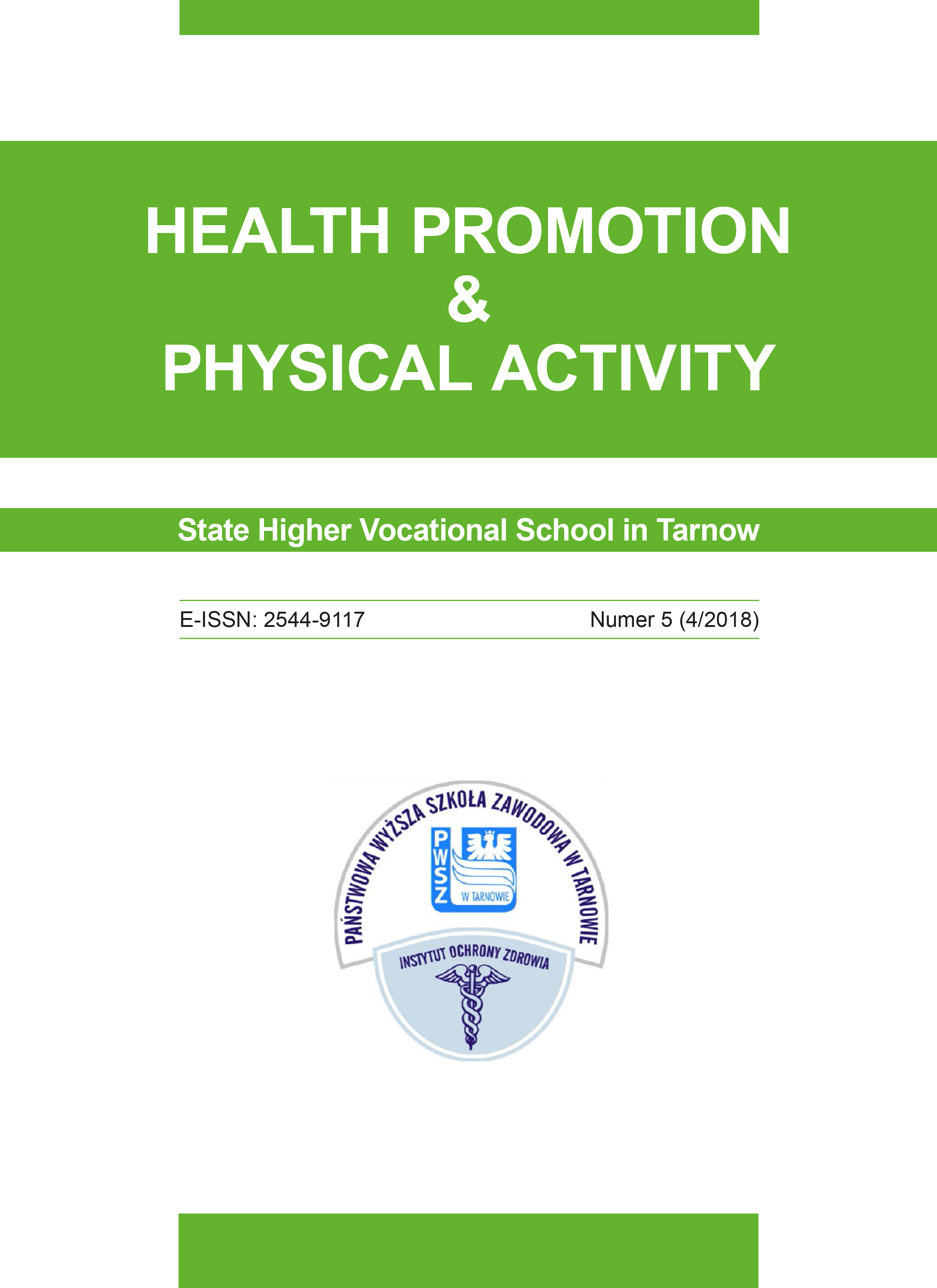The Influence of BMI Value and the Percentage of Fat Tissue on the Curvature of the Foot Longitudinal Arch among Students of University of Physical Education in Kraków
DOI:
https://doi.org/10.5604/01.3001.0013.0716Keywords:
foot arch, BMI, fat tissue, studentsAbstract
Introduction: The foot is an essential element of the kinetic system. Performing the supporting function, it maintains the correct body posture, but above all it is used while walking. Feet are vulnerable to all the changes that occur in human environment. The civilisation changes are particularly harmful to the locomotor system.
Material and methods: The research was conducted in the academic year 2014/2015 among the second year Physiotherapy and Physical Education students in the University of Physical Education in Kraków. The total of 93 students took part in the research (48 females and 45 males). The average age of the subjects was 21 years. In order to assess the curvature of the foot longitudinal arch a podoscope was used, whereas the Tanita BC-418 scales were applied to define the BMI value and calculate the percentage of body fat tissue.
Results: A vast majority of the subjects (70.9%) had a normal type of foot longitudinal arch. Higher longitudinal arch occurred more frequently among women than men, the normal type was less frequent. The BMI level was also within the norm among the majority of the students (79.6%). Overweight was more frequent among males than females. Both males and females with the correct BMI value in their majority had normal curvatures of both feet longitudinal arches. The highest percentage (75%) of the regular right foot longitudinal arch was recorded among females with low body fat deposition. In the case of the left foot the percentage was 68.8%. All the males with low fat deposition obtained normal values of the longitudinal arch curvature for both feet.
Conclusions: The subjects most frequently had a regular curvature of foot longitudinal arch. No significant influence of the percentage of fat tissue and BMI value on the Clarke’s angle was recorded.
Downloads
References
Riddiford-Harland D. L., Steel J. R., Baur L. A. (2011). Are the feet of obese children flat or fat? Revisiting the debate. Int J Obes, 35, pp. 115–120. Google Scholar
Malina H. (1996). Wady kończyn dolnych, postępowanie korekcyjne. Wyd. Handlowo-Usługowe „KASPER”, Kraków. Google Scholar
Przysada G., Drużbicki M., Łyszczak N. (2013). Wpływ masy ciała na powstawanie wad stóp u studentów piątego roku fizjoterapii Uniwersytetu Rzeszowskiego. Wydawnictwo UR, 3, Rzeszów. Google Scholar
Gauthier G. (1977). Trouble biomecanique de pied plat. Rev. Chir. Orthop., 8, 736–739. Google Scholar
Walczak M., Napiontek M. (2003). Stopa płaska statyczna dziecięca – kontrowersyjny temat. Chirurgia Narządów Ruchu i Ortopedia Polska, 68(4), 261–267. Google Scholar
Basmajian J. V., Stecko G. (1963). The role of muscles In arch suport of the foot: an electromyographic study. J. Bone Joint Surg., 45A, 1184–1190. Google Scholar
Chen C. H., Huang M. H., Chen T. W., Weng M. C., Lee C. L., Wang G. J. (2006). The correlation between selected measurements from footprint and radiograph of flatfoot. Arch. Phys. Med. Rehabil., 87, 235–239. Google Scholar
Kasperczyk T. (2001). Wady postawy ciała i leczenie. Wydawnictwo „KASPER”, Kraków. Google Scholar
Nowotny J. (red). (2006). Podstawy kliniczne fizjoterapii w dysfunkcjach narządów ruchu. Medipage, Warszawa. Google Scholar
Wilczyński J. (2005). Korekcja wad postawy człowieka. Wydawnictwo Anthropos, Starachowice. Google Scholar
Marecki B. (1996). Anatomia funkcjonalna w zakresie studiów wychowania fizycznego. Układ ruchu. Wydawnictwo AWF Poznań, Warszawa – Poznań. Google Scholar
Puszczałowska-Lizis E. (2011). Częstość występowania płaskostopia podłużnego u młodzieży akademickiej w świetle różnych technik opracowania planktogramu. Wydawnictwo UR, 3, Rzeszów. Google Scholar
Walicka-Cupryś K., Rachwał M., Pacześniak-Jost A., Szeliga E., Magoń G. (2013). Ocena architektury stóp osób dorosłych. Young Sport Science Of Ukraine, 3, 46–54. Google Scholar
Wołos J., Tarach J. S., Klatka M. (2009). Występowanie otyłości i środowiskowych czynników ryzyka miażdżycy w grupie studentów uczelni wyższych w Lublinie. Endokrynologia, Otyłość i Zaburzenia Przemiany Materii, 5(2), 66–72. Google Scholar
Zuzda J., Latosiewicz R., Półjanowicz W. (2010). Badania nad otyłością wśród studentów i studentek Politechniki Białostockiej i Wyższej Szkoły Ekonomicznej w Białymstoku. Ekonomia i Zarządzanie, 2(1), 74–80. Google Scholar
Jankowicz-Szymańska A., Rojek R., Kołpa M., Mikołajczyk E. (2013). Zależność pomiędzy budową somatyczną a ukształtowaniem stóp młodych osób dorosłych. Probl. Hig. Epidemiol., 94(4), 734–739. Google Scholar
Mosór K., Kromka-Szyder M. (2012). Wpływ wybranych czynników na parametry stopy w oparciu o badanie podoskopowe. Aktualne Problemy Biomechaniki, Tom 6, 99–104. Google Scholar
Shibuya N., Jupiter D. C., Ciliberti L. J., VanBuren V., La Fontaine J. (2010). Characteristics of adult flatfoot in the United States. J. Foot Ankle Surg., 49, 363–368. Google Scholar
Abdel-Fattah M. M., Hassanin M. M., Felembane F. A., Nassaane M. T. (2006). Flat foot among Saudi Arabian army recruits: prevalance and risk factors. East Mediterr. Health J., 12, 211–217. Google Scholar
Gravante G., Russo G., Pomara F., et al. (2003). Comparison of ground reaction forces between obese and control young adults during quiet standing on a baropodometric platform. Clin. Biomech., 18(8), 780–782. Google Scholar
Wearing S. C., Grigg N. L., Lau H. C., Smeathers J. E. (2012). Footprint-based estimates of arch structure are confounded by body composition in adults. Journal of Orthopaedic Research, 30(8), 1351–1354. Google Scholar
Hills A. P., Henning E. M., Mc Donald M., Bar-Or O. (2001). Plantar pressure differences between obese and non-obese adults: a biomechanical analysis. Int. J. Obes. 25, 11, 1674–1679. Google Scholar
Tsung B. Y., Zhang M., Fan Y. B., Boone D. A. (2003). Quantitative comparison of plantar foot shapes under different weight-bearing conditions. J. Rehabil. Res. Dev., 40, 6, 517–526. Google Scholar
Trzcińska D., Tabor P., Olszewska E. (2007). Stopy studentów AWF w Warszawie – ocena plantograficzna. Wychowanie Fizyczne i Zdrowotne, 3, 12–17. Google Scholar
Puczałowska-Lizis E. (2012). Związki pomiędzy wysklepieniem podłużnym stóp a wybranymi cechami morfologicznymi u kobiet w wieku 20–27 lat. Wydawnictwo UR, 1, Rzeszów. Google Scholar
Puszczałowska-Lizis E. (2014). Wskaźnik smukłości a wysklepienie podłużne stóp studentów. Hygeia Public Health, 49(1), 98–102. Google Scholar
Downloads
Published
How to Cite
Issue
Section
License
Copyright (c) 2019 University of Applied Sciences in Tarnow, Poland & Authors

This work is licensed under a Creative Commons Attribution-NonCommercial 4.0 International License.









